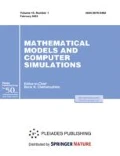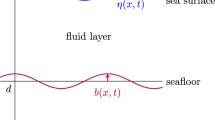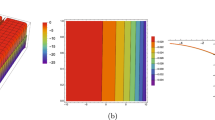Abstract
A numerical model describing the dynamics of the surface gravity waves and acoustic waves induced in the ocean by small dynamic deformations of the bottom is developed. The model is based on the linear potential theory. The model represents a combination of two dynamically coupled blocks: deep-water and shallow. The deep-water block solves a three-dimensional problem of potential wave theory in the sigma-spherical coordinates; the shallow block solves a two-dimensional problem of shallow water theory in the spherical coordinates. The results of testing the numerical model using the analytical solution of the problem for the flat horizontal bottom are presented. A comparative analysis of the simulation results of tsunamis on November 15, 2006 and January 13, 2007 on the Central Kuril Islands with the use of the newly developed and conventional long-wave models is performed.







Similar content being viewed by others
REFERENCES
V. V. Titov, F. I. Gonzalez, H. O. Mofjeld, and A. J. Venturato, “NOAA time Seattle tsunami mapping project: procedures, data sources, and products,” NOAA Tech. Memorandum OAR PMEL-124 (2003).
F. Imamura, A. C. Yalciner, and G. Ozyurt, Tsunami Modelling Manual (TUNAMI Model) (2006).
A. I. Zaytsev, A. G. Chernov, A. C. Yalciner, E. N. Pelinovsky, and A. A. Kurkin, MANUAL Tsunami Simulation/Visualization Code NAMI DANCE, vers. 4.9 (2010).
O. V. Bulatov and T. G. Elizarova, “Regularized shallow water equations for numerical simulation of flows with a moving shoreline,” Comput. Math. Math. Phys. 56, 661–679 (2016).
M. A. Nosov, “Tsunami waves of seismic origin: the modern state of knowledge,” Izv. Atmos. Ocean. Phys. 50, 474–484 (2014).
F. I. González and E. A. Kulikov, “Tsunami dispersion observed in the deep ocean,” in Tsunamis in the World (Springer, Netherlands, 1993), pp. 7–16.
S. Glimsdal, G. K. Pedersen, C. B. Harbitz, and F. Løvholt, “Dispersion of tsunamis: does it really matter?,” Nat. Hazards Earth Syst. Sci. 13, 1507–1526 (2013).
S. Watada, S. Kusumoto, and K. Satake, “Traveltime delay and initial phase reversal of distant tsunamis coupled with the self-gravitating elastic earth,” J. Geophys. Res. Solid Earth 119, 4287–4310 (2014).
B. W. Levin and M. A. Nosov, Physics of Tsunamis, 2nd ed. (Springer, Cham, Heidelberg, New York, Dordrecht, London, 2016).
P. A. Madsen, R. Murray, and O. R. Sørensen, “A new form of the Boussinesq equations with improved linear dispersion characteristics,” Coast. Eng. 15, 371–388 (1991).
F. Løvholt, G. Pedersen, and S. Glimsdal, “Coupling of dispersive tsunami propagation and shallow water coastal response,” Open Oceanogr. J. 4, 71-82 (2010).
F. Shi, J. T. Kirby, J. C. Harris, J. D. Geiman, and S. T. Grilli, “A high-order adaptive time-stepping TVD solver for Boussinesq modeling of breaking waves and coastal inundation,” Ocean Model. 43–44, 36–51 (2012).
J. Kim, G. K. Pedersen, F. Løvholt, and R. J. LeVeque, “A Boussinesq type extension of the GeoClaw model-a study of wave breaking phenomena applying dispersive long wave models,” Coast. Eng. 122, 75–86 (2017).
M. A. Nosov, “Tsunami generation in compressible ocean,” Phys. Chem. Earth, Part B: Hydrol., Oceans Atmos. 24, 437–441 (1999).
G. R. Gisler, “Tsunami simulations,” Ann. Rev. Fluid Mech. 40, 71–90 (2008).
M. Ewing, I. Tolstoy, and F. Press, “Proposed use of the T phase in tsunami warning systems,” Bull. Seismol. Soc. Am. 40, 53–58 (1950).
E. A. Okal, P. J. Alasset, O. Hyvernaud, and F. Schindelé, “The deficient T waves of tsunami earthquakes,” Geophys. J. Int. 152, 416–432 (2003).
M. A. Nosov, S. V. Kolesov, A. V. Ostroukhova, A. B. Alekseev, and B. W. Levin, “Elastic oscillations of the water layer in a tsunami source,” Dokl. Earth Sci. 404, 1097–1100 (2005).
M. A. Nosov and S. V. Kolesov, “Elastic oscillations of water column in the 2003 Tokachi-oki tsunami source: in-situ measurements and 3-D numerical modelling,” Nat. Hazards Earth Syst. Sci. 7, 243–249 (2007).
W. Li, H. Yeh, K. Hirata, and T. Baba, “Ocean-bottom pressure variations during the 2003 Tokachi-Oki Earthquake,” in Nonlinear Wave Dynamics, Ed. by P. Lynett (World Scientic, Singapore, 2009), pp. 109–126.
T. Ohmachi, H. Tsukiyama, and H. Matsumoto, “Simulation of tsunami induced by dynamic displacement of seabed due to seismic faulting,” Bull. Seismol. Soc. Am. 91, 1898–1909 (2001).
B. H. Choi, E. Pelinovsky, D. C. Kim, I. Didenkulova, and S. B. Woo, “Two- and three-dimensional computation of solitary wave runup on non-plane beach,” Nonlin. Processes Geophys. 15, 489–502 (2008).
T. Maeda and T. Furumura, “FDM simulation of seismic waves, ocean acoustic waves, and tsunamis based on tsunami-coupled equations of motion,” Pure Appl. Geophys. 170, 109–127 (2013).
A. Kozelkov, A. Kurkin, E. Pelinovskii, and V. Kurulin, “Modeling the cosmogenic tsunami within the framework of the Navier-Stokes equations with sources of different types,” Fluid Dyn. 50, 306–313 (2015).
A. Bolshakova, S. Inoue, S. Kolesov, H. Matsumoto, M. Nosov, and T. Ohmachi, “Hydroacoustic effects in the 2003 Tokachi-oki tsunami source,” Russ. J. Earth. Sci. 12, ES2005 (2011). https://doi.org/10.2205/2011ES000509
L. D. Landau and E. M. Lifshitz, Course of Theoretical Physics, Vol. 6: Fluid Mechanics (Pergamon, Oxford, 1987; Nauka, Moscow, 1986).
M. A. Nosov, A. V. Moshenceva, and S. V. Kolesov, “Horizontal motions of water in the vicinity of a tsunami source,” Pure Appl. Geophys. 170, 1647–1660 (2013).
M. A. Nosov, A. V. Bolshakova, and S. V. Kolesov, “Displaced water volume, potential energy of initial elevation, and tsunami intensity: analysis of recent tsunami events,” Pure Appl. Geophys. 171, 3515–3525 (2014).
A. F. Blumberg and G. L. Mellor, “A description of a three-dimensional coastal ocean circulation model,” in Three-Dimensional Coastal Ocean Models, Ed. by N. Heaps, Vol. 4 of Coastal and Estuarine Series (Am. Geophys. Union, 1987), pp. 1–16.
M. A. Nosov, “Adapting a mesh when simulating tsunami waves,” Math. Model. Comput. Simul. 10, 431–440 (2018).
Y. Kaneda, H. Matsumoto, M. A. Nosov, and S. V. Kolesov, “Analysis of pressure and acceleration signals from the 2011 Tohoku earthquake observed by the DONET seafloor network,” J. Disaster Res. 12, 163-175 (2017).
M. A. Nosov, “Tsunami generation in a compressible ocean by vertical bottom motions,” Izv., Atmos. Ocean. Phys. 36, 661–669 (2000).
M. A. Nosov and S. V. Kolesov, “Optimal initial conditions for simulation of seismotectonic tsunamis,” Pure Appl. Geophys. 168, 1223–1237 (2011).
Y. Okada, “Surface deformation due to shear and tensile faults in a half-space,” Bull. Seismol. Soc. Am. 75, 1135-1154 (1985).
M. A. Nosov and K. A. Sementsov, “Calculation of the initial elevation at the tsunami source using analytical solutions,” Izv., Atmos. Ocean. Phys. 50, 539–546 (2014).
Funding
This study was supported by the Russian Foundation for Basic Research, project nos. 16-55-50018 and 16-05-00053.
Author information
Authors and Affiliations
Corresponding author
Additional information
Translated by N. Podymova
Rights and permissions
About this article
Cite this article
Nosov, M.A., Kolesov, S.V. Combined Numerical Model of Tsunami. Math Models Comput Simul 11, 679–689 (2019). https://doi.org/10.1134/S2070048219050156
Received:
Revised:
Accepted:
Published:
Issue Date:
DOI: https://doi.org/10.1134/S2070048219050156




